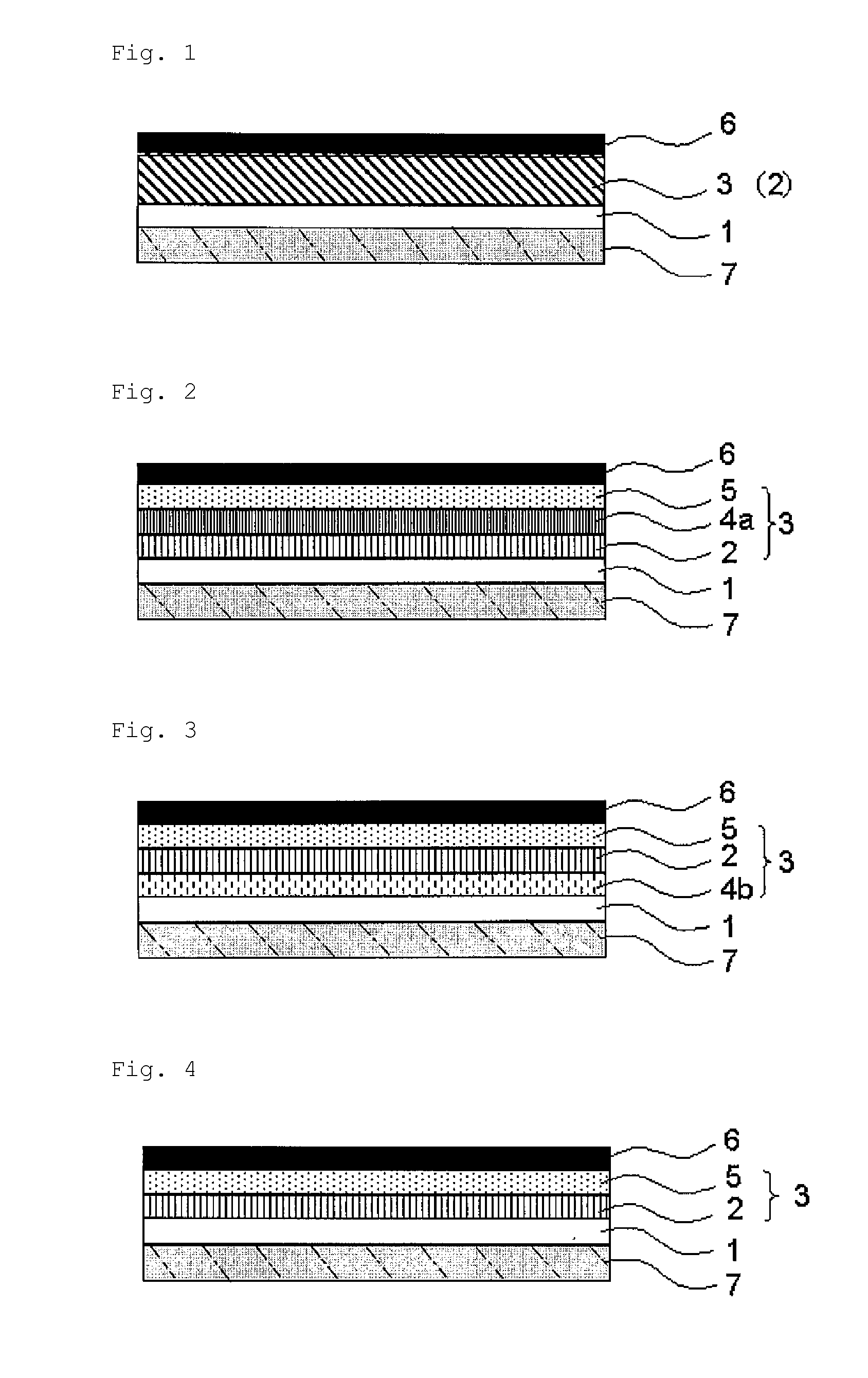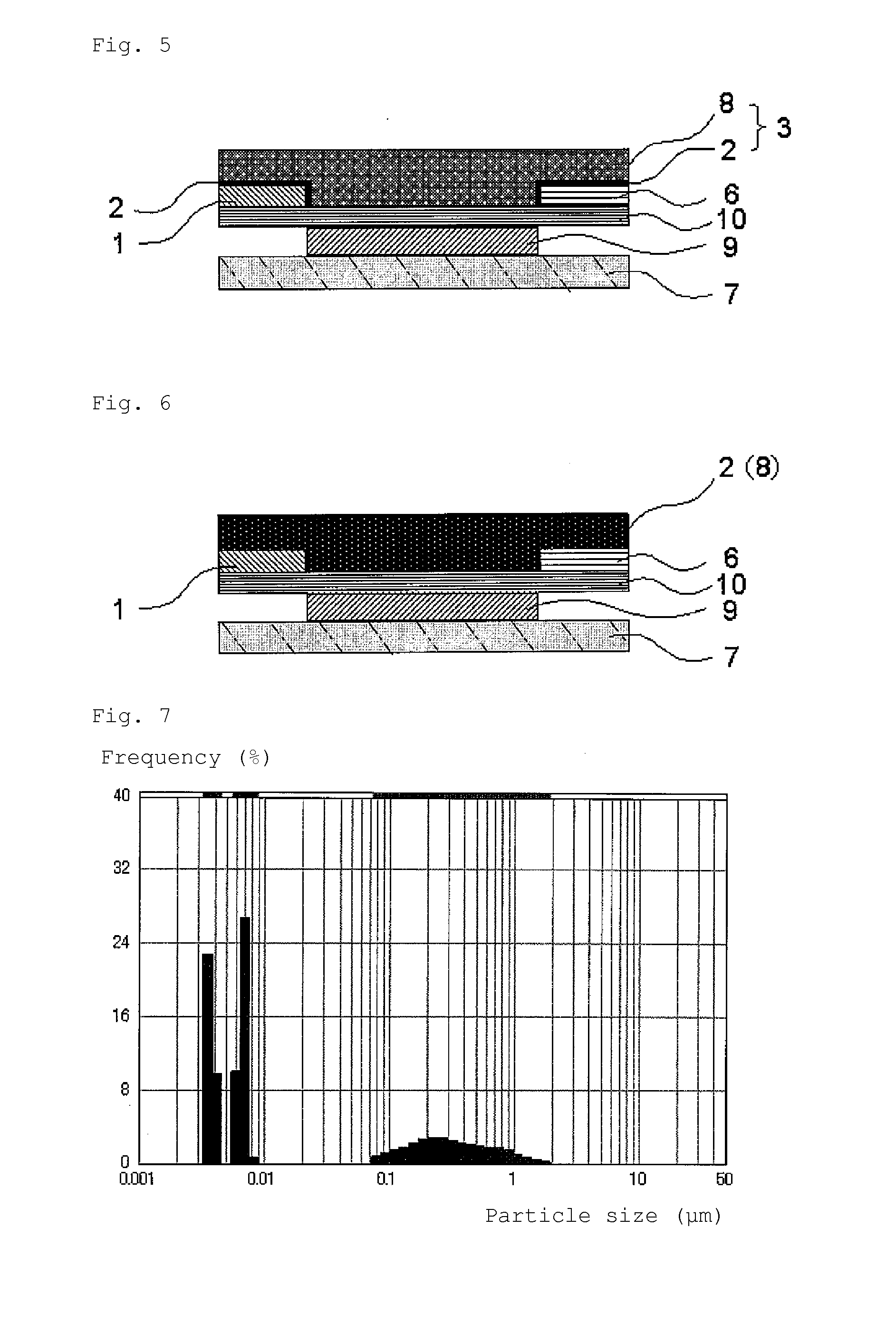Organic electronic device and method for producing the same
a technology of electronic devices and electronic components, applied in the direction of solid-state devices, semiconductor devices, thermoelectric devices, etc., can solve the problems of difficult electrical charge injection and element driving, and achieve the effects of improving hydrophilicity/hydrophobicity, film strength and flexibility, and high power efficiency and long li
- Summary
- Abstract
- Description
- Claims
- Application Information
AI Technical Summary
Benefits of technology
Problems solved by technology
Method used
Image
Examples
synthesis example 1
Synthesis Method for Water-Soluble Mo154 Clusters 1
[0247]After placing a magnetic stirrer in a 100 mL round-bottomed flask, disodium molybdate (VI) dihydrate (3.04 g), distilled water (25 mL) and 35% hydrochloric acid (2.47 mL) were added. Next, sodium dithionite (0.15 g) was added and the mixture was stirred at room temperature for 24 hours. The mixture was then allowed to stand for 5 days and the precipitated dark blue solid was filtered out and rinsed with cold water. The dark blue oily matter was transferred to a sample bottle and dried in a desiccator, to obtain dark blue solid water-soluble molybdenum oxide clusters (hereunder referred to simply as “Mo clusters 1”) (1.46 g).
[0248]Successful synthesis of Mo clusters 1 was confirmed by Fourier transform infrared spectroscopy (FT-IR) and Raman spectroscopy.
[0249]In FT-IR, an FT-IR apparatus by Varian (FTS6000) was used for measurement by the KBr method. The intensity distribution at each wavelength was measured by FT-IR to analyz...
synthesis example 2
Synthesis Method for Water-Soluble Mo146 Clusters 2
[0253]After placing a magnetic stirrer in a 100 mL round-bottomed flask, disodium molybdate (VI) dihydrate (3.04 g), distilled water (25 mL), 35% hydrochloric acid (2.47 mL) and formic acid (1 mL) were added. Next, sodium dithionite (0.15 g) was added and the mixture was stirred at room temperature for 24 hours. The mixture was then allowed to stand for 5 days and the precipitated dark blue solid was filtered out and rinsed with cold water. The dark blue oil was transferred to a sample bottle and dried in a desiccator, to obtain dark blue solid water-soluble molybdenum oxide clusters (hereunder referred to simply as “Mo clusters 2”) (0.43 g). Absorption wavenumbers: νcm−1,1617, 974, 912, 820, 747, 632, 557.
example 1
[0273]The substrate used was prepared by coating a photosensitive resist onto the ITO anode of an ITO-attached glass panel (product of Sanyo Vacuum Industries Co., Ltd., ITO film thickness: 150 nm) and performing mask exposure, development and etching for strip pattern formation to obtain a pattern-formed ITO substrate, and this was subjected to ultrasonic cleaning with a neutral cleanser and ultrapure water in that order, and to UV ozone treatment.
[0274]Next, 0.04 g of Na15[MoVI126MoV28O462H14(H2O)70]0.5[MoVI124MoV28O457H14(H2O)68]0.5.400H2O clusters, as the aqueous polyoxometalate chemically synthesized in Synthesis Example 1 (also referred to as “Mo154 clusters” or “Mo clusters 1”) was dissolved in 10 g of distilled water to prepare a coating ink as a hole injecting layer-forming coating solution. The coating ink was used for coating by spin coating onto the cleaned anode to a dry hole injecting layer film thickness of 10 nm, to form a hole injecting layer coating film. After for...
PUM
| Property | Measurement | Unit |
|---|---|---|
| Nanoscale particle size | aaaaa | aaaaa |
| Time | aaaaa | aaaaa |
| Time | aaaaa | aaaaa |
Abstract
Description
Claims
Application Information
 Login to View More
Login to View More - R&D
- Intellectual Property
- Life Sciences
- Materials
- Tech Scout
- Unparalleled Data Quality
- Higher Quality Content
- 60% Fewer Hallucinations
Browse by: Latest US Patents, China's latest patents, Technical Efficacy Thesaurus, Application Domain, Technology Topic, Popular Technical Reports.
© 2025 PatSnap. All rights reserved.Legal|Privacy policy|Modern Slavery Act Transparency Statement|Sitemap|About US| Contact US: help@patsnap.com



